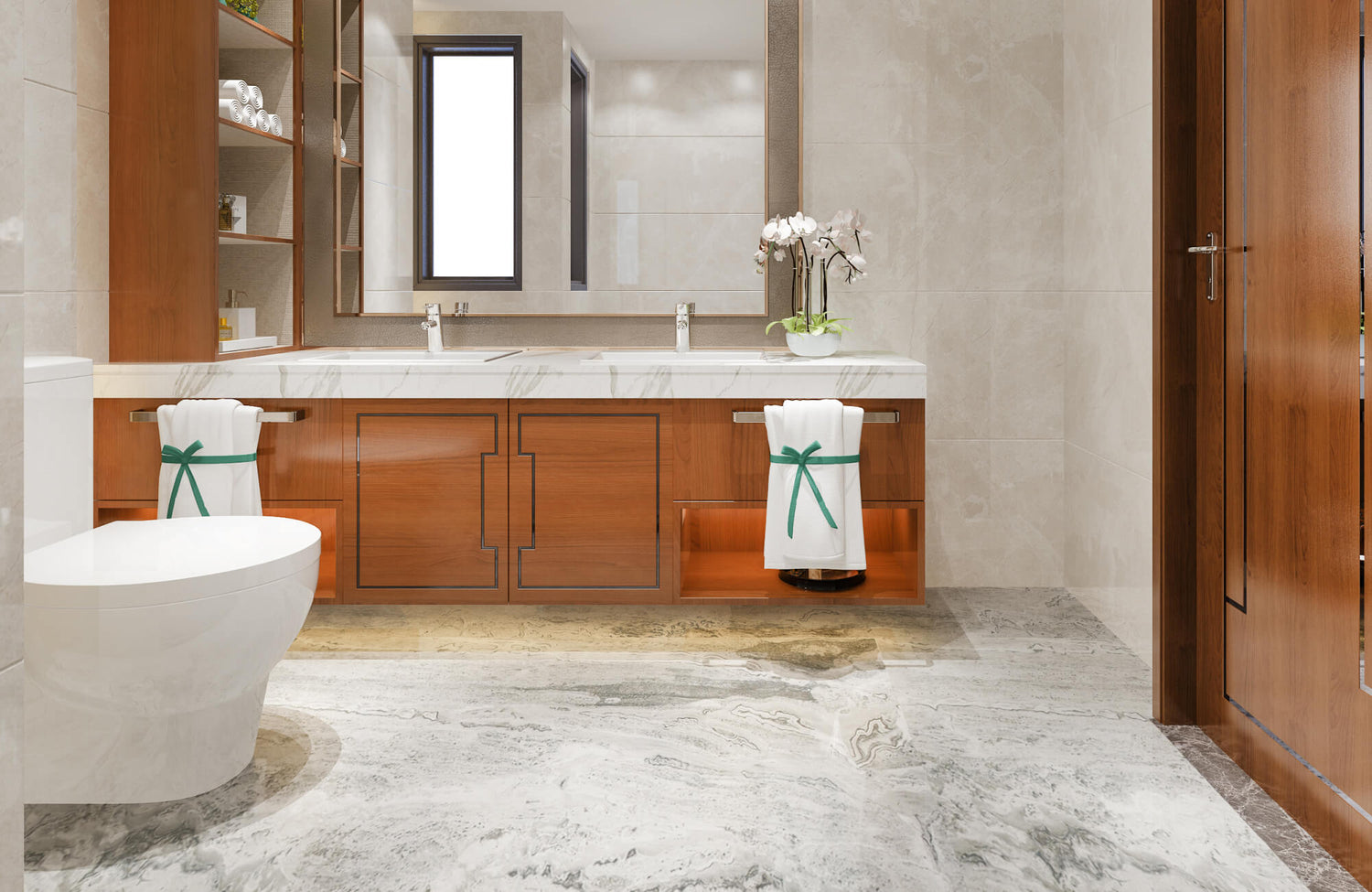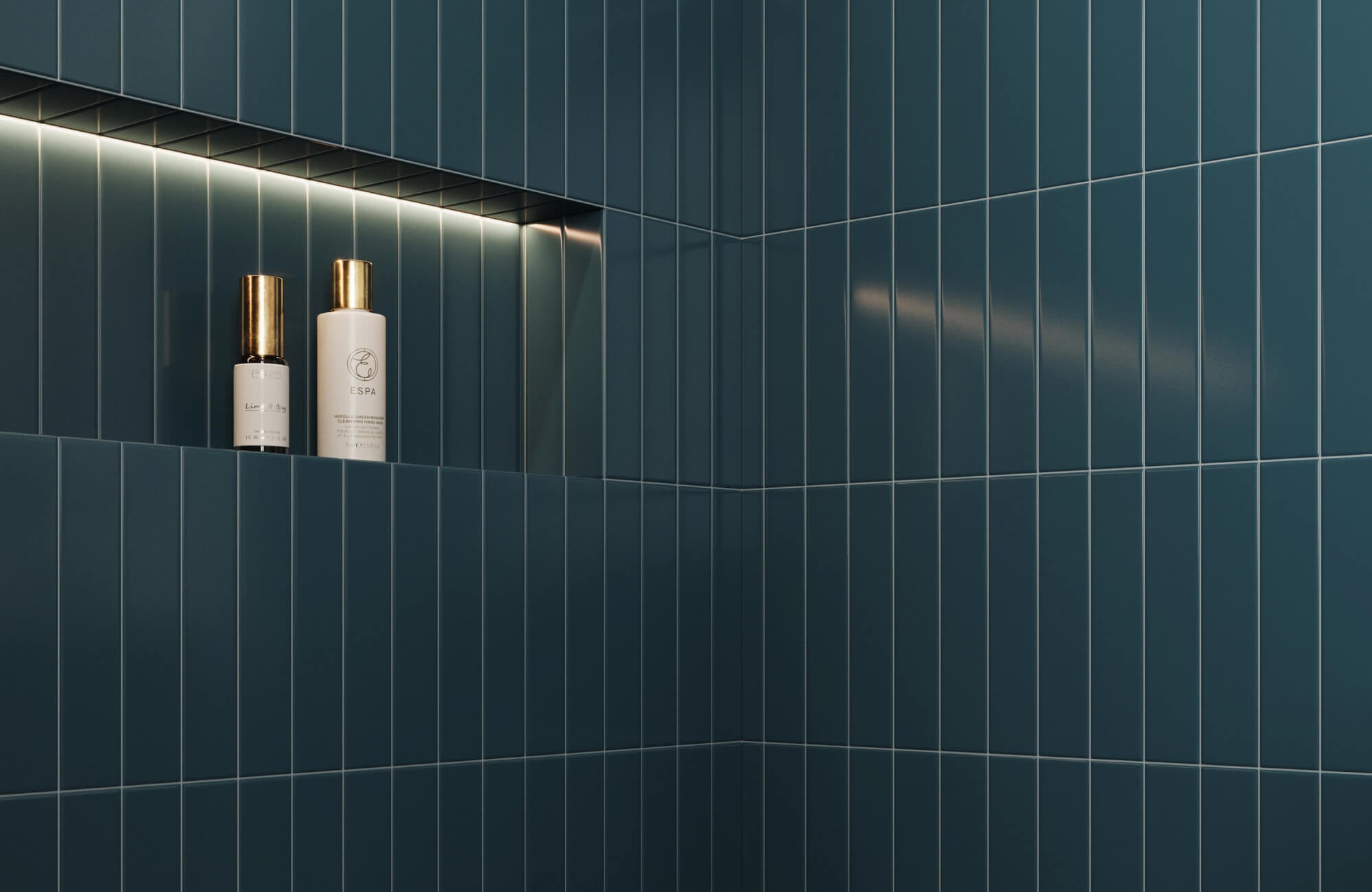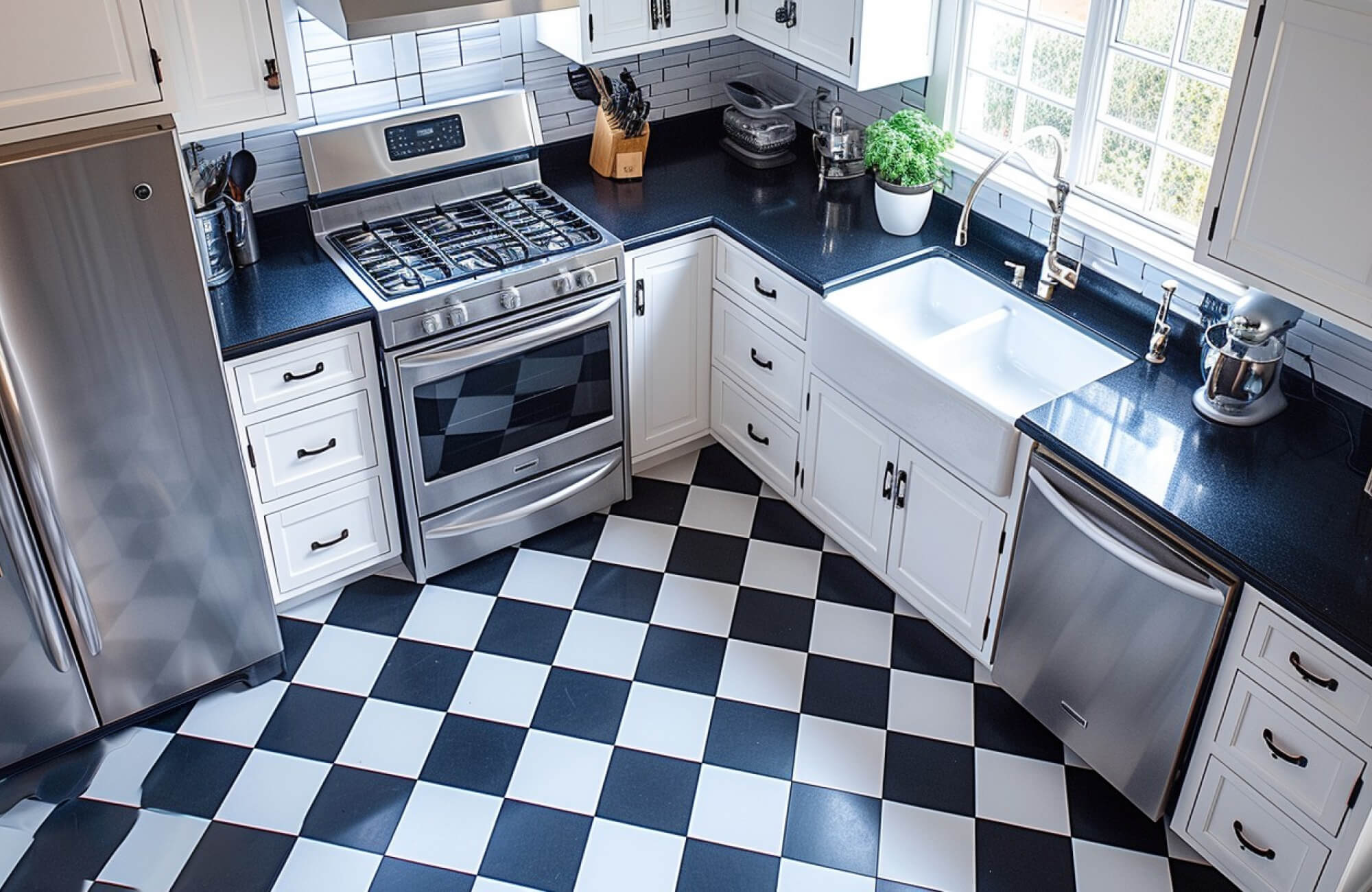Known for its elegance and lasting appeal, marble stands out as a timeless natural stone, frequently becoming the centerpiece in residential and commercial spaces alike. Its unique veining and luxurious appearance make it a top choice for high-end projects. However, a common misconception remains: many believe marble tiles are naturally waterproof. While this material is indeed beautiful and strong, it is not impervious to water damage.
For those who love the marble aesthetic but seek an option better suited for moisture, marble look tiles offer a compelling alternative, capturing the beauty of natural marble with enhanced durability in wet environments. To appreciate why marble remains a cherished choice and how to use it thoughtfully, let’s first understand its unique composition and sensitivity to water.

Understanding Marble: Beauty and Limitations
Marble, a metamorphic rock formed over millions of years through the transformation of limestone under intense heat and pressure, is renowned for its unique crystalline structure. This process creates marble’s distinctive veining and reflective surface, making it a favored material for both classic and modern designs. Its availability in a variety of colors and patterns adds to its versatility, while its light-reflective properties enhance interior brightness. Additionally, marble's natural thermal properties help regulate temperature, further increasing its appeal.
Despite its beauty and durability, marble is not naturally waterproof. Its porous structure makes it prone to absorbing water, which can result in staining, etching, or even structural weakening over time. The microscopic pores in the stone allow moisture to seep in, which may cause discoloration—particularly when water carries impurities like dirt or oils. In areas with high humidity, retained moisture can encourage the growth of mold and mildew, impacting both the appearance of the marble and the level of care it requires.

Protecting Your Marble Investment
Preserving marble’s appearance and durability in moisture-prone areas requires a proactive approach. By combining proper care, sealing, and expert installation, marble can retain its elegance and functionality, even in challenging environments.
Regular maintenance is the first step in protecting marble surfaces. Cleaning with a mild, pH-neutral cleaner and a soft cloth helps prevent dirt and grime from settling into the stone's pores, which can compromise its appearance over time. To avoid unnecessary damage, harsh or acidic cleaners should also be avoided, as they weaken sealants and harm the surface. With consistent care, marble’s polished finish can be preserved, ensuring it remains both beautiful and durable.
Sealing marble tiles adds an extra layer of protection as well, limiting water and stain absorption. Impregnating sealants, which penetrate the stone’s pores, provide long-lasting defense against moisture, while topical sealants offer surface-level protection but require more frequent reapplication. Applying sealants properly, following manufacturer instructions, ensures the best results. For optimal performance, reapplication is typically recommended every 12 to 18 months. Although sealing enhances water resistance, it works best when paired with regular cleaning and mindful care, creating a comprehensive protective system.
In addition to care and sealing, proper installation is crucial for ensuring marble’s longevity in moisture-prone areas. Collaborating with skilled professionals ensures precision during the cutting, laying, and grouting processes. Professionals also understand marble’s specific vulnerabilities, applying techniques to mitigate potential moisture-related issues. Furthermore, using high-quality, water-resistant grout during installation strengthens the seal between tiles, preventing water infiltration and maintaining the stone's stability.
By integrating consistent maintenance, effective sealing, and professional installation, marble can withstand the challenges of high-moisture environments like kitchens and bathrooms. These measures not only safeguard its structure but also allow its natural beauty to shine for years to come, making marble a practical and enduring choice for any space.

Marble Tiles in High-Moisture Areas
Using marble in high-moisture areas such as kitchens and bathrooms requires thoughtful consideration. Here’s how marble performs in these specific settings and what you can do to make it work effectively.
Bathroom Vanities and Floors
The luxurious look of marble makes it a popular choice for bathroom vanities and floors. However, as previously highlighted, marble’s porous nature and high-moisture exposure in bathrooms call for careful consideration. Stains and etching from water, soap, and other products can detract from its beauty if not managed properly.
When choosing marble for bathrooms, it's essential to opt for types that are inherently more resistant to moisture and scratching. Dolomitic marble, for instance, is denser and harder than traditional calcite-based marble, making it better suited for busy, wet environments. Honed finishes are also a smart choice, as they are less slippery and show scratches and etching less visibly than polished surfaces.
Remember, sealing and consistent cleaning are crucial to protect the marble from water damage. Additionally, use non-abrasive cleaning products and soft cloths to preserve the surface. Employing bathroom mats and rugs in high-activity areas can also minimize wear and protect the marble from excessive moisture exposure.
Kitchen Backsplashes
Marble backsplashes bring a timeless elegance to kitchens with their unique veining and sophisticated appeal. Their heat-resistant properties also make them a safe and stylish choice for walls near stovetops. However, marble’s porous nature makes it prone to staining from acidic substances like citrus juice, wine, or tomato sauce, requiring mindful care.
To maintain a marble backsplash, regular sealing is essential to minimize porosity and protect against stains. Clean up spills promptly to prevent damage, and avoid abrasive cleaners that can dull the finish. For additional protection, use a cutting board during food preparation to safeguard against scratches and wear.

Alternative Materials: When Marble Isn’t the Best Choice
Materials like ceramic and porcelain offer practical alternatives to marble in high-moisture areas. These materials can mimic marble’s elegance while providing durability and requiring less upkeep.
Ceramic Marble Look Tiles
Ceramic marble look tiles provide a versatile and affordable alternative to marble, especially suited for high-moisture environments. Edward Martin’s Alessandra 13x39 Leathered Ceramic Tile in Arabescato Deco, as displayed in the photo above, is an ideal example, featuring a sophisticated leathered texture and intricate patterns that bring depth and character to any space.
These tiles are also particularly suitable for bathroom walls, kitchen backsplashes, and other areas where water resistance is needed but heavy impact is less of a concern. Additionally, they are easy to clean, requiring only a mild detergent and occasional maintenance, making them a convenient option for busy households.
Porcelain Marble Look Tiles
Porcelain marble look tiles stand out as a premium choice for high-moisture settings. Created through a high-temperature firing process, these tiles become denser than ceramic, making them less porous and more resistant to moisture, scratches, and stains. Their durability also makes them particularly well-suited for areas like bathroom floors and even the outdoors.
Edward Martin’s Aniston 24x48 Polished Porcelain Tile in Calacatta Antico is an exceptional example. Featuring a polished surface, intricate veining, and a large format, it effortlessly brings a touch of sophistication to both contemporary and classic interiors. Unlike natural marble, this tile also only requires a little more than regular cleaning with a pH-neutral cleaner and does not need sealing.
For those considering porcelain options in high-moisture areas but concerned about achieving the perfect look and fit, Edward Martin offers an innovative augmented reality (AR) tool. This tool allows you to visualize marble look tiles within your space, helping you see how various patterns, colors, and textures interact with your specific lighting and layout. By experiencing the design virtually, you can confidently decide on the ideal placement and style before committing, ensuring that your bathroom or kitchen design aligns perfectly with your vision.
Comparison Between Natural Marble and Marble Look Tiles
For homeowners and designers seeking the elegance of marble, both natural marble and marble look tiles offer distinct advantages. Understanding their differences can help you decide which option best suits your style, budget, and maintenance preferences.
|
Feature |
Natural Marble |
Marble Look Tiles |
|
Aesthetic Appeal |
Unique veining and natural variation; each slab is one-of-a-kind. |
Consistent, customizable designs that closely replicate marble’s appearance. |
|
Durability |
Porous and susceptible to scratching, staining, and etching; requires sealing. |
Non-porous, highly resistant to water, stains, and scratches, ideal for high-moisture areas. |
|
Maintenance |
Requires regular sealing and careful cleaning with pH-neutral products to prevent damage. |
Low-maintenance; can be cleaned with mild soap and water, and no sealing is necessary. |
|
Cost |
Higher cost per square foot due to material and installation expenses. |
More affordable, both for material and installation, while still offering a luxurious look. |
|
Environmental Impact |
Natural stone extraction can impact the environment; limited in sustainable options. |
Often made with eco-friendly practices, including recycled content and energy-efficient production. |
Making the Best Choice
In conclusion, while marble tiles bring a timeless beauty to any space, their porous nature makes them vulnerable to water absorption and damage in high-moisture environments. To mitigate some risks, proper sealing and maintenance is necessary. For those seeking a durable, low-maintenance alternative, porcelain marble look tiles, in particular, offer an ideal solution. Their non-porous structure resists moisture without the need for frequent sealing, making them well-suited for bathrooms, kitchens, and other moisture-prone areas while delivering the same elegance as marble.
To help you explore the best fit for your design, Edward Martin offers high-quality 4" x 4" samples that accurately reflect the color and finish of each tile within our collections. This allows you to confidently choose the perfect tile with a true sense of its premium look and feel, ensuring a beautiful and lasting result in any space.








